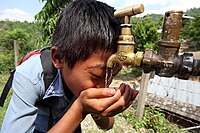
Photo from wikipedia
Abstract Background Groundwater is a common domestic water source in developing countries, but is persistently contaminated with enteropathogens. However, studies on determinants of diarrhoea have predominantly focused on piped water.… Click to show full abstract
Abstract Background Groundwater is a common domestic water source in developing countries, but is persistently contaminated with enteropathogens. However, studies on determinants of diarrhoea have predominantly focused on piped water. This study examines the relationship between groundwater microbial quality and household diarrhoea occurrence (HDO). Methods Considering it as a proxy of enteropathogens, this study analysed Escherichia coli concentrations in groundwater wells. Ordinary kriging, a geostatistical technique in geographic information systems, was used to interpolate the E. coli concentration to survey points that had secondary survey data (n=942). The relationship between E. coli and HDO using simple and multivariate statistical analyses in SPSS was analysed. Results A total of 77% of households used groundwater. One-third of households were without piped-water access (PWA), and these households were significantly more likely to use groundwater than those with PWA. Of the 87 households that reported HDO, 77% were groundwater users. Of the groundwater users, the households with HDO consumed groundwater with significantly higher E. coli concentrations than the households without HDO. Of the households without PWA, the increase in the E. coli concentration increased the odds of HDO (adjusted odds ratio=3.15; 95% CI=1.07–9.22). Conclusion It is suggested that the groundwater microbial quality is a risk factor for HDO and illustrates this by an application of an interpolation technique relevant for developing countries.
Journal Title: International Health
Year Published: 2018
Link to full text (if available)
Share on Social Media: Sign Up to like & get
recommendations!